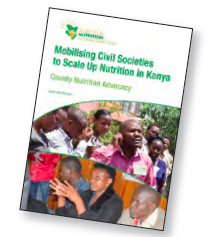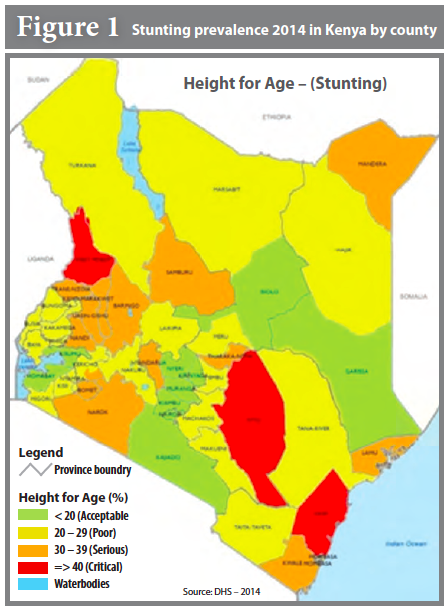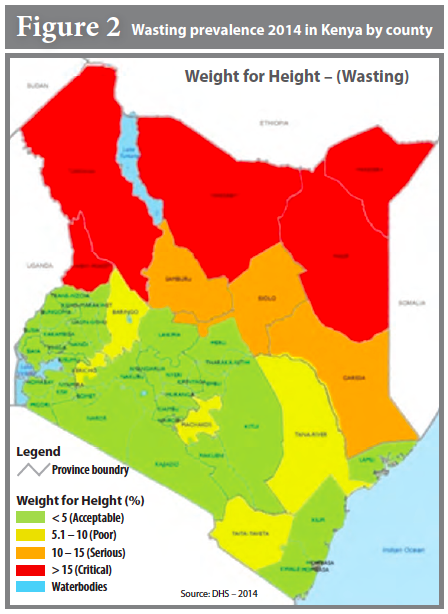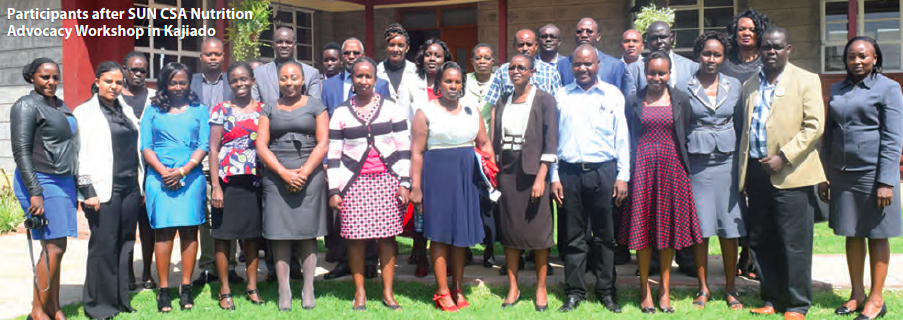Nutrition advocacy in Kenya’s newly devolved government system
 Titus Mung’ou was the Advocacy and Communications Manager at Action Against Hunger (ACF) at the time of writing.
Titus Mung’ou was the Advocacy and Communications Manager at Action Against Hunger (ACF) at the time of writing.
Jacob Korir is the Head of Health and Nutrition and Health Department at ACF Kenya Mission. He is the current Chair of the SUN CSA
Background
The Kenya Demographic Health Survey (KDHS) 2014 indicates significant progress in nutrition in Kenya over the past five years. Stunting levels decreased from 35% to 26%; wasting rates declined from 7% to 4%; and the proportion of underweight children dropped from 16% to 11%. The 2015 Global Nutrition Report declared Kenya the only country in the world classified as being on course to meet all five maternal and child nutrition targets1. Despite the progress, however, malnutrition continues to pose a risk to the lives and livelihoods of a significant proportion of the population.
Since 2013, stakeholders in Kenya’s nutrition sector have been realigning programmes to address the devolution of political, economic and decision-making power to the 47 newly created counties2. Under the new constitution, the health sector – including nutrition – is fully devolved to county-level governments, along with water and some treasury services. Sensitisation of nutrition sector actors on the structures and operations of governments is therefore essential for the successful implementation of nutrition programmes in these counties. This article reflects on some of the progress to date.


National and county-level responsibilities in the health sector3
The Kenya Health Policy 2014-2030 proposes the formation of county health departments whose role will be to create and provide an enabling institutional and management structure responsible for “coordinating and managing the delivery of healthcare mandates and services at the county level.” The county health management teams provide “professional and technical management structures” to coordinate the delivery of services through health facilities in each county.
However, allocation of funds remains poor. A World Bank study notes that Kenya, as a signatory to the 2001 Abuja Declaration, “committed to allocating at least 15 percent of its national budget to health. Not only is Kenya spending a relatively low amount (7% in 2013) as a percentage of GDP on healthcare, but the allocation of funds to public facilities has been uneven.”4 Primary care facilities and community health play a significant role as the first point of contact in the provision of healthcare services.
In recent years, the nutrition spotlight has been on county level. According to the KDHS 2014, more than ten counties are grappling with deteriorating malnutrition levels5.
With fewer than 15 out of 47 counties in Kenya making positive progress in scaling up nutrition, there is a huge task to consolidate efforts in the rest of the counties. Nutrition stakeholders have to overcome limited resources, low awareness of the importance of good nutrition, inadequate policies and weak coordination mechanisms across sectors in order to reverse the malnutrition trends.
The SUN Movement networks, through the leadership of the government-appointed SUN Focal Point in the Ministry of Health Nutrition and Dietetics Unit, have been developing strategies and guidelines. This includes the Advocacy, Communication and Social Mobilization (ACSM) Strategy, which aims to:
- Mobilise multi-stakeholders to support scaling up nutrition;
- Identify and build the capacity of county nutrition champions;
- Support and strengthen coordination of health and nutrition programmes;
- Lobby county governments to increase the number of nutritionists;
- Support the review of County Integrated Development Plans (CIDPs) to improve the status of nutrition;
- Advocate to county governments to increase nutrition budgets;
- Work with media to sensitise communities to scale up nutrition; and
- Conduct county media training on reporting nutrition issues.
The SUN Civil Society Alliance (SUN CSA) has mobilised 44 civil society organisations (CSOs) at national level and 30 others at county level. With funding from the SUN Multi-Partner Trust Fund, the network has established eight county CSA subnational/ county chapters with members such as women and youth groups and human rights and consumer associations not traditionally seen as part of the nutrition sector. In 2015, SUN CSA conducted two SUN sensitisation workshops for representatives of the business community in West Pokot and Isiolo counties which led to the formation of the public-private sector partnership for nutrition in West Pokot County, a major milestone for SUN at the grassroots level.
Another achievement in the 2015/16 financial year in some counties was successful advocacy to county governments to recruit more nutritionists. West Pokot County, which has the highest prevalence of stunting in Kenya (45.9%)6, now has one nutritionist per 27,000 population, compared to one per 82,000 last year. The nutritionists help ensure access to optimal, high-impact nutrition services. They are government employees on government payroll.
County nutrition champions
A key task of SUN networks has been to identify nutrition champions at national and county levels to drive the nutrition agenda. Kenya’s First Lady became Nutrition Patron in March 2015. At least seven county First Ladies (wives of governors), politicians and celebrities have been identified and have accepted the role of nutrition champions. First Lady Margaret Kenyatta’s Beyond Zero Campaign has integrated nutrition issues in its maternity mobile clinic initiative that is targeting counties, especially those grappling with access to quality health services. On 16 December 2015, SUN CSA held a county nutrition champions workshop7 in which participants came up with four key recommendations:
- To build capacity of nutrition champions to promote nutrition through the media;
- To develop nutrition messages for nutrition champions translated to their mother tongue;
- To complete county Nutrition Action Plans to enable the champions to push for specific budget lines in county budgets;
- To organise a two-day nutrition advocacy training for county nutrition champions, to include over 20 First Ladies.
Way forward and next steps
Sensitisation of county-level stakeholders on SUN, the ACSM strategy, development of criteria for identification of nutrition champions, guidelines for engagement with parliamentarians, formation of new county SUN CSA chapters and coordination of nutrition advocacy trainings are among key activities earmarked by the SUN networks this year. The goal is to mobilise diverse stakeholders and leaders to prioritise nutrition, while building capacity of nutrition actors to position nutrition as a development agenda.
While the establishment of a SUN Multi-Stakeholder Platform at the national level seeks to position nutrition coordination in the Office of the President, the quest by SUN networks is to position nutrition in the Office of the County Governors. This has partly been achieved following the identification and sensitisation of nutrition champions from five counties in December 2015.
Training of county-level journalists on nutrition reporting, support to journalists to cover nutrition programmes, and sensitisation of nutrition technical staff to work with the media have been bolstered in at least six counties supported by SUN CSA. The training of more than 45 journalists, mostly from the counties, on nutrition reporting is expected to transform public views and perception on scaling up nutrition.
Documentation of malnutrition situation, best practices and research findings will be prioritised by SUN networks to improve evidence-based advocacy. Through joint field trips to nutrition projects in the counties by technical officers, key decision-makers and journalists, more awareness of the real situation is expected to lead to increased allocation of resources. Another important step will be to capture and upload data onto the website of the Ministry of Health Nutrition and Dietetics Unit,8 which has created pages for counties. The first SUN CSA best practice booklets covering national and county advocacy activities were published in 2015.
Conclusion
As Kenya enters a new chapter in health and nutrition, the nutrition landscape is being aligned steadily following the establishment of SUN networks, sensitisation of key stakeholders on nutrition issues, identification of nutrition champions and integration of nutrition programmes into the devolved government system.
Devolution to the county governments is expected to strengthen the quest to tackle malnutrition at community level. In the past two years, SUN networks and stakeholders at the national level have been supporting counties to develop their CIDPs, cost their county Nutrition Action Plans, and lobby for the creation of clear budget lines for nutrition programmes. Despite the high levels of undernutrition in some counties, there is light at the end of the tunnel thanks to the progress Kenya is making in being on track to meet World Health Assembly nutrition targets.

References
1 Stunting, overweight, wasting, exclusive breastfeeding and anaemia (the sixth, low birth weight is not included in the GNR report rating)
2 Devolution of Health Care Services in Kenya. Lessons Learnt from Other Countries, KPMG 2013, p3,
3 Source: Constitution of Kenya, 2010. Fourth Schedule.
4 Regional Comparison of Total Health Budget as a Percentage of GDP 2010-2011 p3.
5 Kenya Demographic Health Survey 2014 Key Indicators Report p35.
6 Kenya Demographic Health Survey 2014.
7 County Nutrition Champions Workshop Report 2015. Available here.
